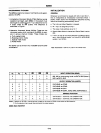
8259A
INTERRUPT
MASKS
Each
Interrupt Request Input
can
be
masked Indlvldu-
,ally
by the Interrupt Mask Register
(IMR)
programmed
through
OCW1.
Each
bit
In
the
IMR
masks one Interrupt
channel If It Is
set
(1).
Bit 0 masks
IRO,
Bit 1 masks
IR1
and
so forth. Masking
an
IR
channel does not affect the
other
channels operation.
SPECIAL
MASK
MODE
Some applications
may
require
an
interrupt service
routine to
dynamically alter the system priority struc-
ture during its execution under software control. For
example, the routine
may
wish to inhibit lower priority
requests for a portion
of
its execution but enable some
of
them for another portion.
The
difficulty here
Is
that
if
an
Interrupt Request is
acknowledged
and
an
End
of Interrupt command did not
reset its
IS
bit (i.e., while executing a service routine),
the
8259A
would
have
inhibited all lower priority
requests with no easy
way
for the routine to enable
them
That is where the
Special Mask Mode comes
In.
In
the
special Mask Mode,
when
a mask bit is set in
OCW1,
it
inhibits further interrupts at that
level
and
enables Inter-
rupts from all other levels (lower
as
well
as
higher) that
are
not masked.
Thus, any interrupts
may
be
selectively enabled by
loading the mask register.
The
special Mask Mode is set by
OCW3
where:
SSMM
=
1,
SMM
=
1,
and
cleared where
SSMM
=
1,
SMM=O.
BUFFERED
MODE
When
the
8259A
Is used in a large system where bus
driving buffers are required
on
the data bus and the cas-
cading mode is used, there exists the problem
of
enabl-
Ing
buffers.
The
buffered mode will structure the
8259A
to send
an
enable Signal on Sfi/EN to enable the buffers.
In
this
mode, whenever the 8259A's data bus outputs
are
ena-
bled, the
SP/EN
output becomes active.
This modification forces the use
of
software program-
ming to determine whether the 8259Ais a master or a
slave. Bit 3 in
ICW4
programs the buffered mode,
and
bit
2
in
ICW4
determines whether it is a master or a slave.
9-48
FULLY
NESTED
MODE
This mode is entered after Initialization unless another
mode is programmed. The interrupt requests are
ordered
in
priority form 0 through 7
(0
highest).
When
an
interrupt is acknowledged the highest priority request is
determined and its vector
placed
on
the bus. Additional-
ly,
a bit of the Interrupt Service register
(ISO-7)
is set.
This bit remains set until the microprocessor issues
an
End
of Interrupt
(EOI)
command immediately before
returning from the service routine, or
if
AEOI
(Automatic
End
of Interrupt) bit is set, until the trailing edge of the
last
INTA.
While the
IS
bit is set, all further interrupts
of
the
same
or lower priority
are
inhibited, while higher
levels will generate
an
interrupt (which will be
acknowledged only
If
the microprocessor internal Inter-
rupt enable flip-flop
has
been
re-enabled through soft-
ware).
After the Initialization sequence,
IRO
has
the highest
priority
and
IR7
the lowest. Priorities
can
be
changed,
as
will
be
explained,
In
the rotating priority mode.
THE
SPECIAL FULLY
NESTED
MODE
This mode will
be
used
In
the case
of
a big system
where cascading
Is
used,
and
the priority
has
to
be
con-
served within each slave. In this case the fully nested
mode will
be
programmed to the master (using
ICW4).
This mode
Is
similar to the normal nested mode with the
following exceptions:
a.
When
an
Interrupt request from a certain slave is in
service this
slave Is not locked out from the master's
priority
logic
and
further interrupt requests from
higher priority
IR's within the slave will
be
recognized
by the master
and
will initiate Interrupts to the proc-
essor.
(In
the normal nested mode a slave is masked
out
when
Its request is in service
and
no
higher
requests from the same
slave
can
be
serviced.)
b.
When
exiting the Interrupt Service routine the soft-
ware
has
to check whether the interrupt servlced
was
the only one from that slave. This is done
by
sending
a non-specific
End
of
Interrupt
(EOI)
command to the
slave
and
then reading Its In-Service register
and
checking for
zero.
If
it is empty, a non-specific
EOI
.
can
be
sent to the master too.
If
not,
no
EOI
should
be
sent.


















